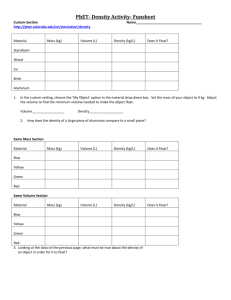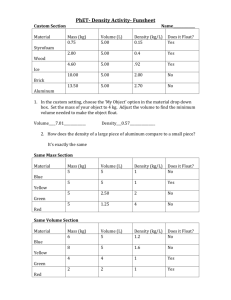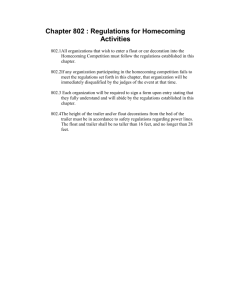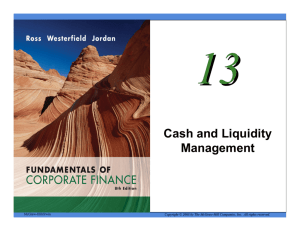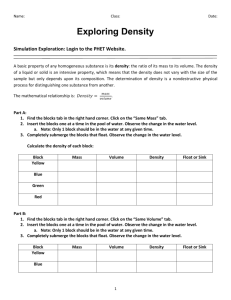Chap019
advertisement
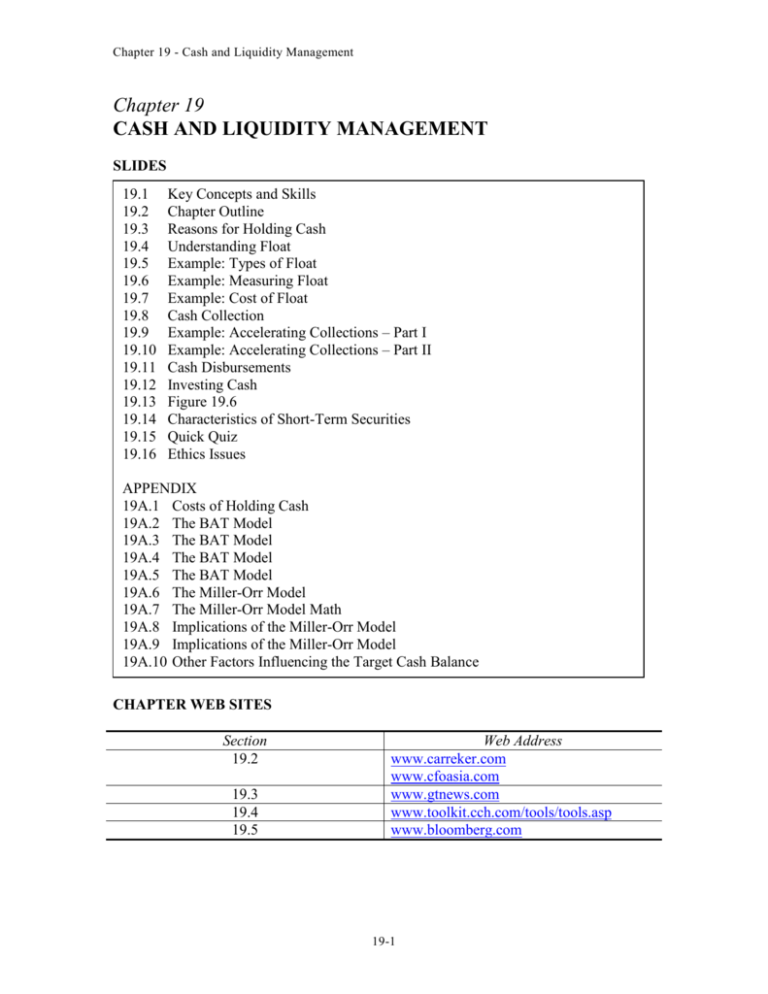
Chapter 19 - Cash and Liquidity Management Chapter 19 CASH AND LIQUIDITY MANAGEMENT SLIDES 19.1 19.2 19.3 19.4 19.5 19.6 19.7 19.8 19.9 19.10 19.11 19.12 19.13 19.14 19.15 19.16 Key Concepts and Skills Chapter Outline Reasons for Holding Cash Understanding Float Example: Types of Float Example: Measuring Float Example: Cost of Float Cash Collection Example: Accelerating Collections – Part I Example: Accelerating Collections – Part II Cash Disbursements Investing Cash Figure 19.6 Characteristics of Short-Term Securities Quick Quiz Ethics Issues APPENDIX 19A.1 Costs of Holding Cash 19A.2 The BAT Model 19A.3 The BAT Model 19A.4 The BAT Model 19A.5 The BAT Model 19A.6 The Miller-Orr Model 19A.7 The Miller-Orr Model Math 19A.8 Implications of the Miller-Orr Model 19A.9 Implications of the Miller-Orr Model 19A.10 Other Factors Influencing the Target Cash Balance CHAPTER WEB SITES Section 19.2 19.3 19.4 19.5 Web Address www.carreker.com www.cfoasia.com www.gtnews.com www.toolkit.cch.com/tools/tools.asp www.bloomberg.com 19-1 Chapter 19 - Cash and Liquidity Management CHAPTER ORGANIZATION 19.1 Reasons for Holding Cash The Speculative and Precautionary Motives The Transaction Motive Compensating Balances Costs of Holding Cash Cash Management versus Liquidity Management 19.2 Understanding Float Disbursement Float Collection Float and Net Float Float Management Electronic Data Interchange and Check 21: The End of Float? 19.3 Cash Collection and Concentration Components of Collection Time Cash Collection Lockboxes Cash Concentration Accelerating Collections: An Example 19.4 Managing Cash Disbursements Increasing Disbursement Float Controlling Disbursements 19.5 Investing Idle Cash Temporary Cash Surpluses Characteristics of Short-Term Securities Some Different Types of Money Market Securities 19.6 Summary and Conclusions Appendix 19A Determining the Target Cash Balance A. The Basic Idea B. The BAT Model C. The Miller-Orr Model: A More General Approach D. Implications of the BAT and Miller-Orr Models E. Other Factors Influencing the Target Cash Balance 19-2 Chapter 19 - Cash and Liquidity Management ANNOTATED CHAPTER OUTLINE Slide 19.1 Slide 19.2 19.1. Key Concepts and Skills Chapter Outline Reasons for Holding Cash Slide 19.3 Reasons for Holding Cash A. The Speculative and Precautionary Motives Speculative motive – take advantage of unexpected opportunities Precautionary motive – cash for emergencies Lecture Tip: What is needed to satisfy the speculative and precautionary motives is an ability to pay quickly – a need that is met with liquidity. Although cash is the most liquid asset, assets such as marketable securities are near substitutes for cash. The ability to borrow quickly is also a close substitute for cash (having a line of credit, for example). Although holding cash and near-cash assets imposes opportunity costs on the firm, it can be shown that the existence of this “financial slack” is consistent with shareholder wealth maximization. The ability to take advantage of unexpected and often temporary, financial opportunities is clearly valuable to the firm. Myers and Majluf demonstrated in the Journal of Financial Economics (1984) that the lack of financial slack could cause financial decision makers to forgo positive NPV projects because of the negative signal sent by issuing equity. The key is to find the balance between financial slack and excess liquidity. B. The Transaction Motive Day-to-day cash requirements to meet expenses C. Compensating Balances Cash balances held as part of a loan agreement or as compensation for bank services received 19-3 Chapter 19 - Cash and Liquidity Management Lecture Tip: A compensating balance requirement serves both as a term of a loan imposed by the lender and as compensation for services rendered by the bank. As such, it is sometimes negotiable. For example, the borrower can attempt to have the size of the required balance reduced or negotiate the nature of the terms. Rather than requiring that the company maintain $100,000 balance at all times, the lender may agree to allow the firm to maintain an average balance of $100,000 over a specified period. The latter case gives the borrower more flexibility. You should also point out that firms that normally hold significant amounts of liquid assets do not find a compensating balance requirement constraining. However, for many firms, it is cheaper to pay explicit fees to obtain a loan than it is to maintain large no- or lowinterest-bearing accounts. D. Costs of Holding Cash The opportunity cost of holding cash is the return that could be earned by investing the cash in other assets. However, there is also a cost to converting between cash and other assets. The optimal cash balance will consider the trade-off between these costs to minimize the overall cost of holding cash. Lecture Tip: It may be helpful to have students consider how they handle their personal cash balances. Some may deposit their paychecks or student loan proceeds in a non-interest-paying checking account to use throughout the semester. Point out that they are forgoing interest that they might receive on a savings account, even though the balance might approach a low level by the end of the term. If a student wants to maximize the interest earned on a savings account, s/he must carefully monitor the checking account balance to make sure that checks are able to clear. There is a happy medium between having too much idle cash and too little. Interest bearing checking accounts have mitigated the need for this balancing act to some extent. The same concepts hold true for a corporation. E. Cash Management versus Liquidity Management Liquidity management is a fairly broad area that concerns the optimal quantity of liquid assets a firm should have, including accounts receivable and inventory. Cash management deals with the optimization of the collection and disbursement of cash. 19.2. Understanding Float 19-4 Chapter 19 - Cash and Liquidity Management Book balance – the amount of cash recorded in the accounting records of the firm Available balance – the amount of cash the bank says is available to be withdrawn from the account (may not be the same as the amount of checks deposited less the amount of checks paid, because deposits are not normally available immediately) Float = Available balance – book balance Slide 19.4 Understanding Float A. Disbursement Float Positive float implies that checks that have been written have not yet cleared. The company needs to make sure that it adjusts the available balance so that it does not think that there is more money to spend than there actually is. Disbursement float – generated by checks the firm has written that have not yet cleared the bank; arrangements can be made so that this money is invested in marketable securities until needed to cover the checks B. Collection Float and Net Float Negative float implies that checks that have been deposited are not yet available. The firm needs to be careful that it does not write checks over the available balance, or the checks may bounce. Collection float – generated by checks that have been received by the firm but are not yet included in the available balance at the bank Managers need to be more concerned with net float and available balances than with the book balance. Slide 19.5 Example: Types of Float 19-5 Chapter 19 - Cash and Liquidity Management Lecture Tip: It may help to personalize the issue of float. Ask the students if they have ever written a check a day or two before receiving their paycheck, even though, on the day when the check was mailed, their checking account had insufficient funds to cover it. This is an example of using disbursement float. We recognize that the time for the check to travel through the mail and then be processed and cleared should allow enough time for the paycheck to clear our bank. We do need to be careful about this process, however. The check we wrote may go through the system faster than anticipated, and it may take the paycheck longer to become available than anticipated. In this case, our check may bounce, or at the very least our credit line is tapped and we end up paying some unexpected interest charges. C. Float Management The three components of float are: -Mail float – the time the check is in the mail -Processing float – handling time between receipt and deposit -Availability float – time for the check to clear the banking system Float management – speeding up collections (reducing collection float) and slowing down disbursements (increasing disbursement float) Slide 19.6 Example: Measuring Float Measuring Float There are two distinct cases: (a) periodic collections and (b) continuous or steady-state collections. For periodic collections, average daily float = (check amount*days delay) / (# days in period) Example – Periodic Collections: Suppose a $10,000 check is mailed to Belief Systems, Inc. every two weeks. It spends two days in the mail, one day at Belief Systems offices and is credited to Belief Systems’ bank account two days after deposit, for a total delay of five days. Over the 14-day period, the float is $10,000 for five days and $0 for nine days; then the cycle starts over. The average float is (5*10,000 + 9*0)/14 = $3,571.43. 19-6 Chapter 19 - Cash and Liquidity Management Example – Continuous Collections: Suppose average daily checks arriving at Hector Company amount to $2,000. The checks take an average of three days to arrive in the mail, one day to process and two days to be credited to the bank account. The total collection delay is six days, and the average daily float is 6*2000 = $12,000. Eliminating all delays would free up $12,000; eliminating one day’s delay would free up $2,000. Real-World Tip: The Expedited Funds Availability Act (EFAA) governs the availability of funds deposited by firms. The following rules apply (based on US Code: Title 12 Section 4002 as of 1/23/00): -Cash or electronic payment and government checks are available the day after deposit. -Local checks are available two days after deposit. -Non-local checks are available five days after deposit. Note that these rules indicate the maximum time for availability. Banks can make funds available sooner if they choose. Also, deposits made at ATMs can have a different schedule due to the processing time required. Cost of Collection Float The benefit of reducing collection delays is directly reflected in the change in average daily float. Every dollar reduction in average daily float is a dollar freed up for use in perpetuity. The change in the average daily float that any plan to hasten collections might make is also the most the firm would be willing to pay for faster collections. Example – Periodic Collections: What is the most that Belief Systems would pay to speed up collections by one day? If the collections delay were reduced from five days to four days, the average daily float would go from $3,571.43 to $2,857.14. So, the most the company would be willing to pay is 3571.43 – 2857.14 = 714.29. Example – Continuous Collections: How much would Hector save if they reduced their collection delay from six days to three? The average daily float for three days’ delay is $6,000, so the company would save 12,000 – 6,000 = $6,000 and this is the most it would be willing to pay. 19-7 Chapter 19 - Cash and Liquidity Management Lecture Tip: The concept of net float can be emphasized with an example that illustrates the changes in the balance sheet that result from an increase in collection float and a decrease in disbursement float. Consider a firm that has credit sales of $100,000 per day. Inventory of $80,000 per day is purchased on credit. The company has an average collection period of 30 days and an average payables period of 20 days. The relevant balance sheet would be as follows: Accounts receivable = $3,000,000 (100,000*30) Accounts payable = $1,600,000 (80,000*20) This situation requires external financing of 3,000,000 – 1,600,000 = $1,400,000. Checks, whether received or sent, have a three-day delay in the mail. Therefore, the company has a net float of -3*100,000 + 3*80,000 = -60,000. If the company could speed up its receivables collection by one day and delay payments by one day, net float would become positive (-2*100,000 + 4*80,000 = 120,000). The initial change to the balance sheet accounts would be: Additional Cash = $180,000 Accounts Receivables = $2,900,000 Accounts Payable = $1,680,000 The accounts receivable debit balance is reduced by $100,000 (source of funds) and the accounts payable account is increased by $80,000 (source of funds). The net source of funds equals the change in float, and the additional cash can be used to decrease the external financing required. Slide 19.7 Example: Cost of Float Real-World Tip: The Institution Investor (September 1985) provides a lengthy discussion of legal and ethical questions surrounding cash management. The article, “Cash management: Where do you draw the line,” by Barbara Donnelly, focuses on the E.F. Hutton check kiting scandal. In retrospect, it is clear that the value of lost reputation far exceeded the savings gained via the company’s cash management strategies. D. Electronic Data Interchange and Check 21: The End of Float? EDI - exchanging information electronically. A financial use is to send invoices electronically and then receive payment electronically. Corporations spend substantial amounts on setting up these systems. Most banks also offer these services, beyond just on-line bill paying, to their retail customers. 19-8 Chapter 19 - Cash and Liquidity Management E. 19.3. Accelerating Collections: An Example Cash Collection and Concentration A. Components of Collection Time Collection Time = mailing time + processing delay + availability delay B. Cash Collection Cash collection policies depend on the nature of the business. Firms can choose to have checks mailed to one or more locations, (reduces mailing time), or allow preauthorized payments. Many firms also accept online payments either with a credit card, with authorization to request the funds directly from your bank, or through online bill paying arrangements. Slide 19.8 Cash Collection C. Lockboxes Lockboxes are special post office boxes that allow banks to process the incoming checks and then send the information on account payment to the firm. They reduce processing time and often reduce mail time because several regional lockboxes can be used. D. Cash concentration The practice of moving cash from multiple banks into the firm’s main accounts. This is a common practice that is used in conjunction with lockboxes. E. Accelerating Collections: An Example Slide 19.9 Example: Accelerating Collections – Part I Slide 19.10 Example: Accelerating Collections – Part II 19.4. Managing Cash Disbursements A. Increasing disbursement float 19-9 Chapter 19 - Cash and Liquidity Management Slowing payments by increasing mail delay, processing time or collection time. May not want to do this from both an ethical standpoint and a valuation standpoint. Slowing payment could cause a company to forgo discounts on its accounts payable. As we will see later in the chapter, the cost of forgoing discounts can be extremely high. Slide 19.11 Cash Disbursement Ethics Note: You may wish to emphasize the importance of ethical behavior in this area of cash management. Because transactions occur frequently and in large amounts, unscrupulous financial managers tend to “cut corners” in this area more often than in some others. Some corporations routinely pay late or take discounts that they do not qualify for. This hurts the suppliers that the company does business with and may ultimately hurt the company through a loss of reputation or credit. Ethical behavior can be summed up in the following rule of thumb proposed by a top executive at a financial management seminar. When asked about a practice similar to the one described above, he responded that he followed the “mother rule” when faced with a decision with ethical consequences – “If you would be comfortable telling your mother what you did, it’s probably ethical.” Of course, this doesn’t work for everyone, but it does hit home with a lot of students. B. Controlling disbursements Minimize liquidity needs by keeping a tight rein on disbursements through any ethical means possible Zero-balance accounts – maintain several sub-accounts at regional banks and one master account. Funds are transferred from the master account when checks are presented for payment at one of the regional accounts. This reduces the firm’s liquidity needs. Controlled disbursement accounts – the firm is notified on a daily basis how much cash is required to meet that day’s disbursements and the firm wires the necessary funds. 19.5. Investing Idle Cash 19-10 Chapter 19 - Cash and Liquidity Management A. Temporary cash surpluses -seasonal or cyclical activities -planned or possible expenditures The goal is to invest temporary cash surpluses in liquid assets with short maturities, low default risk and high marketability Slide 19.12 Investing Cash Slide 19.13 Figure 19.6 B. Characteristics of Short-Term Securities Corporate treasurers seek to acquire assets with the following characteristics: -short maturity -low default risk -high marketability Slide 19.14 Characteristics of Short-Term Securities Lecture Tip: “Marketability” suggests that large amounts of an asset can be bought or sold quickly with little effect on the current market price. This characteristic is usually associated with financial markets that are “broad” and “deep.” Broad markets have a large number of participants; deep markets have participants that are willing and able to engage in large transactions. The market for U.S. T-bills epitomizes these characteristics. There are millions of potential buyers and sellers world-wide, and multi-million dollar transactions are common. C. Some Different Types of Money Market Securities Lecture Tip: Current money market rates are available on a daily basis in The Wall Street Journal. Various money market instruments and their current rates can be found on the “Credit Markets” page in Section C, under the title “Money Rates.” Remind students that these rates change on a daily basis depending on market conditions. This is also a good place to discuss the impact of Fed decisions on short-term rates. 19.6. Summary and Conclusions 19-11 Chapter 19 - Cash and Liquidity Management Slide 19.15 Quick Quiz Slide 19.16 Ethics Issues Appendix 19A DETERMINING THE TARGET CASH BALANCE Target cash balance – the desired cash balance as determined by the trade-off between carrying costs and storage costs. Adjustment costs – costs associated with holding low levels of cash; shortage costs. With a flexible working capital policy, the trade-off is between the opportunity cost of cash balances and the adjustment costs of buying, selling and managing securities. A. The Basic Idea Slide 19A.1 Costs of Holding Cash B. The BAT (Baumol-Allais-Tobin) Model Slide 19A.2 – Slide 19A.5 The BAT Model Define: C = optimal cash transfer amount (amount of marketable securities to sell to raise cash) F = fixed cost of selling securities T = cash needed for transactions over entire planning period R = opportunity cost of cash (interest rate on marketable securities) Assume that cash is paid out at a constant rate through time. Opportunity cost = average cash balance * interest rate = [(C+0)/2]*R Trading cost = # of transactions*cost per transfer = (T/C)*F Total cost = opportunity cost + trading cost = (C/2)R + (T/C)F 19-12 Chapter 19 - Cash and Liquidity Management To find the optimal transfer amount, take a first derivative of the cost function relative to C and set it equal to zero. You can also find it by setting opportunity cost = trading cost and solving for C. Method 1: TC R FT 2 0 C 2 C R FT 2 C2 2 FT C2 R 2 FT C R Method 2: C T R F 2 C 2 TF C2 R 2 FT C R Example: Hermes Co. has cash outflows of $500 per day, the interest rate is 10% and the fixed transfer cost is $25. T = 365*500 = 182,500 F = 25 R = .1 2(25)(182,500) .1 C $9,552.49 C C. The Miller-Orr Model: A More General Approach 19-13 Chapter 19 - Cash and Liquidity Management Slide 19A.6 The Miller-Orr Model Slide 19A.7 The Miller-Orr Model Math The Miller-Orr model offers a general approach to handling uncertain cash flows. The basic idea: U* = upper limit on cash balance L = lower limit on cash balance C* = target cash balance When cash reaches U*, the firm transfers cash (buys securities) in the amount of U* - C*. If cash falls below L, the firm sells C* - L worth of securities to add to cash. Using the model: Given the variance (2) of cash flow (“cash flow” refers to both the amounts that go into and come out of the cash balance) per period, the interest rate per period (period may be a day, week, or month as long as the two are consistent), and L, the target balance and upper limit, are given by: C* = L + ( ¾ * F * 2/R)1/3 U* = 3C* - 2L Example: Suppose F = $25, R = 1% per month, and the variance of monthly cash flows is $25,000,000 per month. Assume a minimum cash balance of $10,000. C* = 10,000 + ( ¾ (25)(25,000,000)/.01)1/3 = $13,605.62 U* = 3(13,605.62) – 2(10,000) = $20,816.86 D. Implications of the BAT and Miller-Orr Models Slide 19A.8 – Slide 19A.9 Implications of the Miller-Orr Model From both: -The higher the interest rate (opportunity cost), the lower the target balance -The higher the transaction cost, the higher the target balance From Miller-Orr: 19-14 Chapter 19 - Cash and Liquidity Management -The greater the variability of cash flows, the higher the target balance E. Other Factors Influencing the Target Cash Balance -Flexible versus restrictive short-term financing policy -Compensating balance requirements -The number and complexity of checking accounts Slide 19A.10 Other Factors Influencing the Target Cash Balance 19-15

